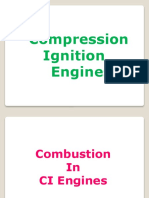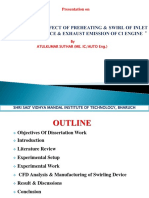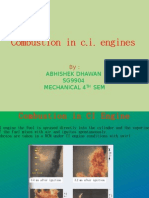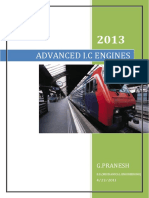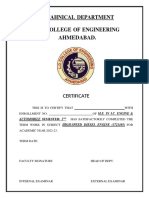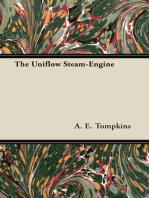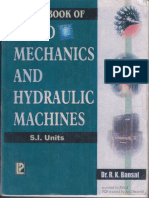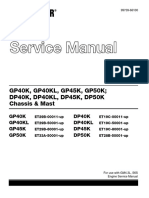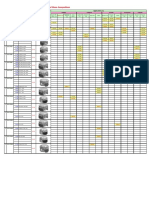ME401 Combustion CI
ME401 Combustion CI
Uploaded by
BalvinderCopyright:
Available Formats
ME401 Combustion CI
ME401 Combustion CI
Uploaded by
BalvinderOriginal Description:
Copyright
Available Formats
Share this document
Did you find this document useful?
Is this content inappropriate?
Copyright:
Available Formats
ME401 Combustion CI
ME401 Combustion CI
Uploaded by
BalvinderCopyright:
Available Formats
Combustion in CI Engines
Essential Features of CI Combustion Combustion in CI Engines & Gas Turbines
Dr. M. Zahurul Haq
Professor Department of Mechanical Engineering Bangladesh University of Engineering & Technology (BUET) Dhaka-1000, Bangladesh zahurul@me.buet.ac.bd http://teacher.buet.ac.bd/zahurul/
ME 401: Internal Combustion Engines
Air alone is compressed in a diesel engine and fuel is injected into the cylinder towards the end of the combustion stroke. Liquid fuel, injected at high velocity as one or more jets through small orices or nozzles in the injector tip, atomizes into small drops and penetrates into the combustion chamber. Fuel vaporizes and mixes with the high-temperature high-pressure cylinder air. Since the air temperature and pressure are above the fuels ignition point, spontaneous ignition of portions of already-mixed fuel and air occurs after a delay period of few crank angle degrees. Cylinder pressure increases as combustion of fuel-air mixture occurs. Consequent heating and compression of unburned portion of charge shortens the ignition delay and fuel vaporization time. Fuel injection continues until desired amount of fuel is injected. Atomization, vaporization, fuel-air (also burned gases) mixing, and combustion continues until combustion process is completed.
1 / 22 c Dr. M. Zahurul Haq (BUET) Combustion in GT & CI Engines ME 401 (2011) 2 / 22 Combustion in CI Engines
c Dr. M. Zahurul Haq (BUET)
Combustion in GT & CI Engines
ME 401 (2011)
Combustion in CI Engines
Since injection commences just before combustion starts, there is no knock limit resulting from spontaneous ignition of end-gas. Injection timing is used to control combustion timing and short ignition delay period is desirable. Engine torque is varied by varying the amount of fuel injected per cycle with essentially unchanged air ow. Engine is operated un-throttled with good part-load eciency relative to SI engine. As fuel injection per cycle is increased, problem with air utilization leads to shoot formation which cannot be burned up prior to exhaust. Soot formation limits the maximum fuel/air ratio to values 20% or more lean of stoichiometric and consequently lower mean eective pressure than SI engine. Since diesel always operates with lean fuel/air ratios and higher values of (= Cp /CV ) over expansion stroke gives higher conversion eciency than SI engine.
e740 c Dr. M. Zahurul Haq (BUET) Combustion in GT & CI Engines ME 401 (2011) 3 / 22 c Dr. M. Zahurul Haq (BUET) Combustion in GT & CI Engines ME 401 (2011) 4 / 22
Combustion in CI Engines
Combustion in CI Engines
Two Categories of Diesel Combustion Systems
1 2
Direct Injection (DI) Systems
Direct-injection (DI) Engines Indirect-injection (IDI) Engines
e743
e742
IDI engine designs are only used in the smallest engine sizes.
c Dr. M. Zahurul Haq (BUET) Combustion in GT & CI Engines ME 401 (2011) 5 / 22
(a) quiescent chamber with multi-hole nozzle typical of larger engines; (b) bowl-in-piston chamber with swirl and multi-hole nozzle; (c) bowl-in-piston chamber with swirl and single-hole nozzle. (b) and (c) used in medium to small DI engine range.
c Dr. M. Zahurul Haq (BUET) Combustion in GT & CI Engines ME 401 (2011) 6 / 22 Combustion in CI Engines
Combustion in CI Engines
Phases of a DI Engine Combustion
Air alone is compressed and raised to a high temperature on the compression stroke. One or more jets of fuels, compressed to a pressure of 100-2000 bar is injected into the engine cylinder. Physical Delay: Fuel jet disintegrates into a core of fuel surrounded by a spray envelope created by atomization and vaporization of fuel. At some location in the spray envelope a mixture of air and fuel will form and oxidation becomes imminent.
e744 c Dr. M. Zahurul Haq (BUET) Combustion in GT & CI Engines ME 401 (2011) 7 / 22
e700 c Dr. M. Zahurul Haq (BUET) Combustion in GT & CI Engines ME 401 (2011) 8 / 22
Combustion in CI Engines
Combustion in CI Engines
Chemical Delay: Reaction starts slowly and then accelerates until inammation or ignition takes place. Ignition Delay = Physical Delay + Chemical Delay. Rapid pressure rise occurs because of the myriad ignition points and the accumulation of fuel in the delay period. Following the stage, the nal portion of the fuel are injected and consequently combustion is regulated by the injection rate. Since the process is far from homogeneous, combustion continues when the expansion stroke is well under way.
e741 1 2 3 4 e701 c Dr. M. Zahurul Haq (BUET) Combustion in GT & CI Engines ME 401 (2011) 9 / 22
Ignition Delay (ab) Premixed or Rapid Burning Phase (bc) Mixing Controlled Combustion Phase (cd) Late Combustion Phase (de)
Combustion in GT & CI Engines ME 401 (2011) 10 / 22 Knock in CI Engines
c Dr. M. Zahurul Haq (BUET)
Combustion in CI Engines
Indirect-Injection (IDI) Systems
IDI systems have divided combustion chamber and rich mixtures in the auxiliary chamber with relatively lean charges in the main chamber are used to achieve extremely low NOx and HC emissions.
Knock in CI Engines
The problem of knock in CI engine is complicated by the added complexity of the physical delay period which is inuenced by:
1 2 3
the density and temperature of air in the cylinder the atomization, penetration and shape of the spray the properties of the fuel, such as volatility and viscosity, which aect the spray characteristics the turbulence of air, which promotes mixing. A high temperature A high density A short delay A reactive mixture
e745
e746
To reduce the possibility of knock in CI engines, fuel/air should have:
(b) Pre-chamber system
(a) Swirl chamber system
Swirl chambers rely on the ordered motion to raise combustion speed, and pre-chambers rely on turbulence to increase combustion speed. Both types uses heat-resistant inserts which is quickly heated up by the combustion process, and then helps to reduce ignition delay.
c Dr. M. Zahurul Haq (BUET) Combustion in GT & CI Engines ME 401 (2011) 11 / 22
c Dr. M. Zahurul Haq (BUET)
Combustion in GT & CI Engines
ME 401 (2011)
12 / 22
Knock in CI Engines
Knock in CI Engines
Temperature Factors in Reducing CI Knock
Density Factors in Reducing CI Knock
Decreasing the temperature of the initially formed mixture by any of the following methods will increase the possibility of knock: Lowering the compression ratio Lowering the inlet air temperature Lowering the coolant temperature Lowering the cylinder and cylinder walls temperature Advancing or retarding the start of injection Injection of fuel after TDC will reduce knock (and power) because of the pressure impact is relieved by the expansion stroke.
Decreasing the temperature of the initially formed mixture by any of the following methods will increase the possibility of knock: Decreasing the inlet air pressure Decreasing the compression ratio Thus raising the compression ratio and supercharging the CI engine, unlike in the SI engine, tends to reduce knock.
c Dr. M. Zahurul Haq (BUET)
Combustion in GT & CI Engines
ME 401 (2011)
13 / 22
c Dr. M. Zahurul Haq (BUET)
Combustion in GT & CI Engines
ME 401 (2011)
14 / 22
Knock in CI Engines
Knock in CI Engines
Time Factors in Reducing CI Knock
Composition Factors in Reducing CI Knock
The possibility of knock in CI engine is decreased by the following factors:
Increasing the amount of fuel in the initially formed mixture, or increasing the time for forming a homogeneous mixture, by any of the following methods will increase the possibility of knock: Decreasing the turbulence of the compressed air Increasing the speed of the engine Decreasing the injection pressure Increasing the rate of injection
Raising the cetane rating of the fuel (decreasing chemical delay) Increasing the volatility of the fuel (decreasing physical delay) Decreasing the viscosity of the fuel (promoting mixing and therefore decreasing physical delay). Fuels with high cetane rating may be undesirable for particular engine since the rise of combustion may be too gradual. Thus, cetane rating of 40-60 are usually specied. If the cetane rating is too low, starting of the engine may be dicult. With high cetane values, the ignition delay may be too short to allow the adequate mixing of fuel with air, and incomplete combustion may result.
c Dr. M. Zahurul Haq (BUET)
Combustion in GT & CI Engines
ME 401 (2011)
15 / 22
c Dr. M. Zahurul Haq (BUET)
Combustion in GT & CI Engines
ME 401 (2011)
16 / 22
Knock in CI Engines
Combustion in Gas Turbines
GT Operating Parameters
GT combustors operates at pressures of 3 atm for small engines to as high as 40 atm for advanced engines. Aircraft engines operate at compression ratios of 20/1 to 40/1, while stationary units operate at 10 to 15 atm. Combustor outlet temperatures are set by the metallurgical requirements of the turbine blades and range from 1300 to 1700o C for aircraft turbines and 1000 to 1500o C for stationary turbines. Combustor inlet temperature depends on the compressor pressure ratio and ranges from 200 to 500o C. The highest cycle eciency is achieved with the highest feasible turbine inlet temperature. Since the stoichiometric ame temperatures of GT fuels is 2000o C or more, 100 to 150% excess air is used to cool the combustor liner to a suitable operating temperature around 800o C.
e751 c Dr. M. Zahurul Haq (BUET) Combustion in GT & CI Engines ME 401 (2011) 17 / 22 c Dr. M. Zahurul Haq (BUET) Combustion in GT & CI Engines ME 401 (2011) 18 / 22
Combustion in Gas Turbines
Combustion in Gas Turbines
Combustion in GT
Fuel in GT is burned almost stoichiometrically with 25 to 35% of the air entering the combustor. The combustion products mix with the remaining air to arrive at a suitable temperature for the turbine. All combustors have the following three zones:
1 2 3
Recirculation zone: fuel is evaporated and partially burned. Burning zone: fuel air mixture burning is completed. Dilution zone: dilution air is mixed with hot gas.
e747
c Dr. M. Zahurul Haq (BUET)
Combustion in GT & CI Engines
ME 401 (2011)
19 / 22
c Dr. M. Zahurul Haq (BUET)
Combustion in GT & CI Engines
ME 401 (2011)
20 / 22
Combustion in Gas Turbines
Combustion in Gas Turbines
e748
e752
e749 c Dr. M. Zahurul Haq (BUET) Combustion in GT & CI Engines ME 401 (2011) 21 / 22 c Dr. M. Zahurul Haq (BUET) Combustion in GT & CI Engines ME 401 (2011) 22 / 22
You might also like
- Lecture15 PDFDocument14 pagesLecture15 PDFsonu kumarNo ratings yet
- Diesel Engine and Steam BoilerDocument0 pagesDiesel Engine and Steam BoilerChathuranga ManukulaNo ratings yet
- Ci EnginesDocument32 pagesCi Enginesammuvarsh100% (1)
- Combustion in CI EnginesDocument12 pagesCombustion in CI EnginesVARUN VARMA JAGANATHNo ratings yet
- Combustion in CI EnginesDocument65 pagesCombustion in CI EnginesNamandeep Singh OberoiNo ratings yet
- Effect of Advanced Injection Timing On The Performance of Natural Gas in Diesel EnginesDocument10 pagesEffect of Advanced Injection Timing On The Performance of Natural Gas in Diesel EnginesGeorge CălinNo ratings yet
- Ic & Ac KeyDocument23 pagesIc & Ac KeyNAGA PAVAN KUMAR ANo ratings yet
- Compression Ignition Engine CombustionDocument81 pagesCompression Ignition Engine CombustionHarish Reddy Singamala100% (1)
- 2) Introduction 2.1) BackgroundDocument26 pages2) Introduction 2.1) BackgroundMahesh BisuralNo ratings yet
- Nandha Engineering College (Autonomous) : 17mex12 - Internal Combustion EnginesDocument36 pagesNandha Engineering College (Autonomous) : 17mex12 - Internal Combustion EnginesSugumar MuthusamyNo ratings yet
- Denso Ecd-VDocument118 pagesDenso Ecd-VIongornistu100% (7)
- 1 STAGES of Combustion in CI EngineDocument22 pages1 STAGES of Combustion in CI Engineselvaraj9223No ratings yet
- Atd - C.I. EnginesDocument68 pagesAtd - C.I. EnginesNishant WaruleNo ratings yet
- Qip Ice 20 in Cylinder Fluid Motion - UnlockedDocument24 pagesQip Ice 20 in Cylinder Fluid Motion - UnlockedWilliamNo ratings yet
- CI Engine CombustionDocument14 pagesCI Engine CombustionRahul MeenaNo ratings yet
- ET Answer KeyDocument9 pagesET Answer KeyGodwinNo ratings yet
- Ic Engine Project ReportDocument6 pagesIc Engine Project ReportAtulkumarSutharNo ratings yet
- 10.5. Ignition Delay: 10.5.1. Definition and DiscussionDocument14 pages10.5. Ignition Delay: 10.5.1. Definition and DiscussionDUVAN FELIPE MUNOZ GARCIANo ratings yet
- Combustion in C.I. EnginesDocument24 pagesCombustion in C.I. EnginesAbhishek Dhawan100% (1)
- Indirect InjectionDocument3 pagesIndirect InjectionSri Ram VikasNo ratings yet
- Actual CyclesDocument12 pagesActual Cyclesjehadyam50% (2)
- Lecture28 PDFDocument8 pagesLecture28 PDFzyzz 10No ratings yet
- Mechanisms of HC Formation in SI Engines.... Contd. The Lecture ContainsDocument7 pagesMechanisms of HC Formation in SI Engines.... Contd. The Lecture ContainsAnkush AgarwalNo ratings yet
- Combustion in CI Engines 1409Document21 pagesCombustion in CI Engines 1409Shriram SubramaniamNo ratings yet
- Lecture 9 Combustion in CI Engines-Stages of Combustion and Ignition DelayDocument19 pagesLecture 9 Combustion in CI Engines-Stages of Combustion and Ignition Delaydivyansh vermaNo ratings yet
- Combustion in Ci-EnginesDocument13 pagesCombustion in Ci-EnginesAli ŞimşekNo ratings yet
- Combustion in CI Engine FDocument45 pagesCombustion in CI Engine Fmahmudul adilNo ratings yet
- Unit IV & V - I.C. Engine and CombustionDocument78 pagesUnit IV & V - I.C. Engine and CombustionS ANANTHAKUMARNo ratings yet
- Group 5 - ICEDocument23 pagesGroup 5 - ICEre2phukanNo ratings yet
- Lecture - 12 IC EngineDocument33 pagesLecture - 12 IC Engine2022052003No ratings yet
- Advanced Ic EnginesDocument13 pagesAdvanced Ic EnginesVenkatesh MecNo ratings yet
- Hcci Diesel Engines Emissions With HCCI Operation Regimes of HCCI and Conventional CI Engine OperationDocument8 pagesHcci Diesel Engines Emissions With HCCI Operation Regimes of HCCI and Conventional CI Engine OperationKeval ParmarNo ratings yet
- Advanced I.C. Engines BookDocument127 pagesAdvanced I.C. Engines BooksivasubramanianNo ratings yet
- Combustion of Dual Fuel Type Natural GasLiquid Diesel Fuel in CompressionChaichan14Document12 pagesCombustion of Dual Fuel Type Natural GasLiquid Diesel Fuel in CompressionChaichan14ennioNo ratings yet
- Comparison of Diesel and Petrol EnginesFrom EverandComparison of Diesel and Petrol EnginesRating: 2.5 out of 5 stars2.5/5 (3)
- Fuel Injection in Ci EnginesDocument47 pagesFuel Injection in Ci EnginesMr. MuditNo ratings yet
- Lecture - 3 Combustion Phases of SI and CI EnginesDocument21 pagesLecture - 3 Combustion Phases of SI and CI EnginesMuhammad SaqibNo ratings yet
- Fundamentos de Motores de Combustión Interna: Real Air-Fuel Engine CyclesDocument25 pagesFundamentos de Motores de Combustión Interna: Real Air-Fuel Engine CyclesAndres Flores GarciaNo ratings yet
- Methods of Improving Engine Performance and EfficiencyDocument34 pagesMethods of Improving Engine Performance and EfficiencyDavid ChikuseNo ratings yet
- Be Afec Unit 06-NotesDocument25 pagesBe Afec Unit 06-NotesAniket BadeNo ratings yet
- FuelSystem CIDieselEngineDocument60 pagesFuelSystem CIDieselEngineOmeh AmakaNo ratings yet
- Study ExpDocument41 pagesStudy ExpNishant Nagle100% (1)
- Ctual Cycles and Their AnalysisDocument7 pagesCtual Cycles and Their AnalysisAndlnatu TDNo ratings yet
- Iit Stratified Charge EnginesDocument20 pagesIit Stratified Charge Enginesa.mech2009100% (2)
- Advanced I.C. Engines BookDocument215 pagesAdvanced I.C. Engines Bookbalasubramanian979No ratings yet
- Chapter 9Document50 pagesChapter 9gonriNo ratings yet
- Combustion Principle and Combustion Chamber of IC EngineDocument35 pagesCombustion Principle and Combustion Chamber of IC EngineRobel DejeneNo ratings yet
- HSD Term 22-23 EvenDocument38 pagesHSD Term 22-23 EvenViraj ParmarNo ratings yet
- FuelSystem CIDieselEngineDocument60 pagesFuelSystem CIDieselEngineberkah fajarNo ratings yet
- Fuel Injection System Solution DG Question Bank by Saidul Islam (Jahed) 35th Batch of BMFADocument22 pagesFuel Injection System Solution DG Question Bank by Saidul Islam (Jahed) 35th Batch of BMFAkh al aminNo ratings yet
- Combustion Engines Iit KanpurDocument20 pagesCombustion Engines Iit Kanpurabhigoyal1989No ratings yet
- How Diesel Engines WorkDocument23 pagesHow Diesel Engines WorkBabu Stunner100% (1)
- Naval Diesel Engineering: The Fundamentals of Operation, Performance and EfficiencyFrom EverandNaval Diesel Engineering: The Fundamentals of Operation, Performance and EfficiencyNo ratings yet
- Hybrid Systems Based on Solid Oxide Fuel Cells: Modelling and DesignFrom EverandHybrid Systems Based on Solid Oxide Fuel Cells: Modelling and DesignNo ratings yet
- Andrew Ginty, Val Hanrahan - AQA Level 2 Certificate in Further Mathematics (2019, Hodder Education) - Libgen - LiDocument302 pagesAndrew Ginty, Val Hanrahan - AQA Level 2 Certificate in Further Mathematics (2019, Hodder Education) - Libgen - LiBalvinderNo ratings yet
- 9709 s15 QP 61Document4 pages9709 s15 QP 61Abrar JahinNo ratings yet
- Radiation Slides m9Document27 pagesRadiation Slides m9Gowtham MurugesanNo ratings yet
- Important Information Required by Candidate Prior To Filling The Online ITI Admission ApplicationDocument1 pageImportant Information Required by Candidate Prior To Filling The Online ITI Admission ApplicationBalvinderNo ratings yet
- Gupta and Gupta Civil EngineeringDocument459 pagesGupta and Gupta Civil EngineeringBalvinder60% (5)
- Surveying Duggal Volume 1Document119 pagesSurveying Duggal Volume 1BalvinderNo ratings yet
- Finite Element BookDocument349 pagesFinite Element Bookanggarinaldi88% (8)
- IES Mechanical Engineering Paper I 2013Document20 pagesIES Mechanical Engineering Paper I 2013Vamsi GuptaNo ratings yet
- IES Mechanical Engineering Paper II 2013 PDFDocument20 pagesIES Mechanical Engineering Paper II 2013 PDFBalvinderNo ratings yet
- Dissertation Final 10-4-07 PDFDocument181 pagesDissertation Final 10-4-07 PDFBalvinderNo ratings yet
- Instructions For Candidates:: WWW - Ptu.ac - inDocument1 pageInstructions For Candidates:: WWW - Ptu.ac - inBalvinderNo ratings yet
- IAS Prelims General Studies 2011 PDFDocument28 pagesIAS Prelims General Studies 2011 PDFBalvinderNo ratings yet
- Compressive Physics XIIDocument1,437 pagesCompressive Physics XIIBalvinder84% (31)
- Revised Interview ScheduleDocument24 pagesRevised Interview ScheduleBalvinderNo ratings yet
- Automotive Welding Technician Level3Document38 pagesAutomotive Welding Technician Level3BalvinderNo ratings yet
- A TextBook of Fluid Mechanics and Hydraulic Machines - Dr. R. K. Bansal PDFDocument287 pagesA TextBook of Fluid Mechanics and Hydraulic Machines - Dr. R. K. Bansal PDFPullavartisrikanthChowdaryNo ratings yet
- Casting Technician Level3Document30 pagesCasting Technician Level3BalvinderNo ratings yet
- Automotive Welding Technician Level4Document38 pagesAutomotive Welding Technician Level4BalvinderNo ratings yet
- Automotive - Q 3502 Machining AssistantDocument17 pagesAutomotive - Q 3502 Machining AssistantBalvinderNo ratings yet
- Part Print AnalysisDocument20 pagesPart Print AnalysisSikander GirgoukarNo ratings yet
- Section-I Programmes Offered, Duration, Intake and EligibilityDocument21 pagesSection-I Programmes Offered, Duration, Intake and EligibilityBalvinderNo ratings yet
- Petrojet Heavy Equipments Workshops: Higher Technological Institute Department of Mechanical EngineeringDocument31 pagesPetrojet Heavy Equipments Workshops: Higher Technological Institute Department of Mechanical EngineeringHagagaNo ratings yet
- 3SA438 DDC Series 60 Specification - Coach SpecDocument2 pages3SA438 DDC Series 60 Specification - Coach SpecMOHD NAJMAN BIN MUDA100% (1)
- Perkins Engines Guide VK - od.UADocument5 pagesPerkins Engines Guide VK - od.UANoui BouzidNo ratings yet
- Model Analysis of Gas Turbine Blades by Varying Fillet Radius With MaterialsDocument5 pagesModel Analysis of Gas Turbine Blades by Varying Fillet Radius With Materialsseventhsensegroup100% (1)
- Automotive Engines Multiple Choice Question and AnswerDocument16 pagesAutomotive Engines Multiple Choice Question and AnswerSathis Kumar100% (6)
- Utc Roadways DepotDocument38 pagesUtc Roadways Depothitesh joshiNo ratings yet
- Clearances Mentioned in Manual.Document3 pagesClearances Mentioned in Manual.AshishNo ratings yet
- Oxygen Sensors: NTK Oxygen Sensors Manufactures and Supplies Over Half of Original Equipment (OE) Oxygen SensorsDocument26 pagesOxygen Sensors: NTK Oxygen Sensors Manufactures and Supplies Over Half of Original Equipment (OE) Oxygen SensorsRanga.SathyaNo ratings yet
- Actual CyclesDocument12 pagesActual Cyclesjehadyam50% (2)
- C27 and C32 Generator Set Engines - PDF Versión 1Document9 pagesC27 and C32 Generator Set Engines - PDF Versión 1William SalgadoNo ratings yet
- Operating Instructions MaK VM46DFDocument258 pagesOperating Instructions MaK VM46DFGaurav100% (1)
- Checking Valve Clearance: ON KX250FDocument1 pageChecking Valve Clearance: ON KX250FRafael Perez GiraldoNo ratings yet
- Important Note: Timing Belt Replacement IntervalsDocument5 pagesImportant Note: Timing Belt Replacement IntervalsAbdulmaola AlmamariNo ratings yet
- F1L511 &F2L511 Air Cooled Diesel Engines: (Engine Photo)Document3 pagesF1L511 &F2L511 Air Cooled Diesel Engines: (Engine Photo)mohamed aliNo ratings yet
- Maintenance Schedule For WARTSILA 20 B-C Engines Wfi 2004N007 02gbDocument12 pagesMaintenance Schedule For WARTSILA 20 B-C Engines Wfi 2004N007 02gbDimitris Paliktoglou100% (4)
- 3 1524 (1500)Document6 pages3 1524 (1500)mkNo ratings yet
- Manual Español, Cat DP50K 5 TDocument80 pagesManual Español, Cat DP50K 5 Tem50% (2)
- YTG30TLV LeafletDocument1 pageYTG30TLV LeafletandriNo ratings yet
- rh560 Hammers Specification Sheet English PDFDocument6 pagesrh560 Hammers Specification Sheet English PDFIng del PeleNo ratings yet
- TechTool TerminologyDocument4 pagesTechTool TerminologyДрагиша Небитни ТрифуновићNo ratings yet
- Kent Cams Fitting and Timing InstructionsDocument2 pagesKent Cams Fitting and Timing InstructionsPeter QuinnNo ratings yet
- Synchronous Motor: AC Motor Rotor Alternating Current Rotating Magnetic FieldDocument5 pagesSynchronous Motor: AC Motor Rotor Alternating Current Rotating Magnetic FieldDeepak SekarNo ratings yet
- BSA Bantam D14-4 Workshop ManualDocument120 pagesBSA Bantam D14-4 Workshop ManualPeter Theodosiussen100% (1)
- Engine BalanceDocument14 pagesEngine BalanceTHYAGARAJAN KSNo ratings yet
- Gea32081a LM6000 - Pa - Us - R1 - LRDocument1 pageGea32081a LM6000 - Pa - Us - R1 - LRErik Van GroningenNo ratings yet
- Carbon X Combustion Chamber Cleaner K1+K2Document2 pagesCarbon X Combustion Chamber Cleaner K1+K2Dhany SSatNo ratings yet
- DC13 071A. 364-371 KW (411 kVA) : EU Stage IIIA, China Phase III and CPCB-IIDocument2 pagesDC13 071A. 364-371 KW (411 kVA) : EU Stage IIIA, China Phase III and CPCB-IIJulio SullaymeNo ratings yet
- 2019+CRF125F Wiring DiagramDocument1 page2019+CRF125F Wiring DiagramKevin McCaigNo ratings yet
- FDB - Parts Manual Vol I 793D Dec 2011Document1,206 pagesFDB - Parts Manual Vol I 793D Dec 2011Oliver100% (1)
- Matrix Piston 2009 PDFDocument1 pageMatrix Piston 2009 PDFTamrin RayezNo ratings yet












